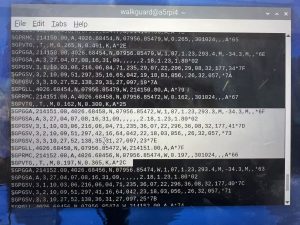Risk and Plans
What are the most significant risks that could jeopardize the success of the project? How are these risks being managed? What contingency plans are ready?
The most significant risk currently is uncertainty regarding the GPS integration. Although the GPS module is connected to the RPi4 via USB, we discovered that it still operates using the I²C protocol. This poses a problem since the RPi4 is already using its two I²C ports for the accelerometer and audio hat. Managing multiple I²C communications on the same bus remains a challenge, and if this does not work, we are considering using the user’s phone GPS as a contingency for location tracking.
To manage the risk posed by the GPS integration issue, we are focusing on exploring the ability of the RPi4 to handle multiple I²C communications on a shared bus, as both the accelerometer and audio hat are already using the available I²C ports. We will test if the GPS module can coexist with the other components, potentially through multiplexing or reconfiguring the communication protocols. If this approach fails, our contingency plan involves using the user’s smartphone GPS as an alternative for location tracking, ensuring seamless functionality without needing additional hardware modifications.
Change in Design
Were any changes made to the existing design of the system (requirements, block diagram, system spec, etc)? Why was this change necessary, what costs does the change incur, and how will these costs be mitigated going forward?
No significant changes to the existing design of the system have been made this week. However, depending on the outcome of our GPS integration tests, we may have to revise the block diagram and communication architecture to account for the potential use of a smartphone for location tracking. This adjustment would affect the system specification but would not incur any significant hardware costs, as it relies on pre-existing smartphone capabilities. We would need to invest more time in modifying the software for seamless integration, which we plan to accommodate by reallocating time from other low-priority tasks if necessary.
Schedule Updates
Provide an updated schedule if changes have occurred.
At this point, our schedule remains unchanged. However, we are closely monitoring the GPS integration process. If further complications arise, we may need to adjust our timeline to allow additional time for testing or the implementation of our contingency plan.
Week-Specifics
Part A: … with consideration of global factors. Global factors are world-wide contexts and factors, rather than only local ones. They do not necessarily represent geographic concerns. Global factors do not need to concern every single person in the entire world. Rather, these factors affect people outside of Pittsburgh, or those who are not in an academic environment, or those who are not technologically savvy, etc.
From a global perspective, WalkGuard addresses the needs of the approximately 3.5% of the global population affected by visual impairment, particularly the 30-40% who must navigate their environments independently. This system provides essential support for users in both developed and developing countries, where access to advanced mobility aids may be limited. WalkGuard’s radar-based obstacle detection and fall alert system not only enhances safety but also promotes independence, reducing the risk of accidents. This technology also provides peace of mind to caregivers, especially in regions with limited healthcare infrastructure, by allowing remote monitoring of loved ones.
The global impact extends beyond just geographic considerations. WalkGuard helps users who are not technologically savvy by offering an intuitive design with audio-based feedback, making it accessible to individuals with varying degrees of technological comfort. Furthermore, as mobility and accessibility issues are universally recognized, WalkGuard aligns with international efforts to improve the quality of life for people with disabilities, contributing to a more inclusive society.
Part B: … with consideration of cultural factors. Cultural factors are encompass the set of beliefs, moral values, traditions, language, and laws (or rules of behavior) held in common by a nation, a community, or other defined group of people.
WalkGuard’s design is sensitive to cultural differences in how disabilities are perceived and accommodated around the world. In many cultures, independence is highly valued, and individuals with disabilities strive to live autonomously. WalkGuard supports this cultural emphasis by providing visually impaired individuals with a tool that enhances their ability to navigate their environments safely, reducing their reliance on others. This aligns with the cultural values of independence and self-reliance found in various communities globally. Additionally, in cultures where caregiving is a family-centered responsibility, WalkGuard’s ability to provide remote monitoring through emergency alerts and GPS tracking can ease the emotional burden on family members, offering them reassurance about their loved one’s safety.
WalkGuard also acknowledges varying levels of technological adaptation across different regions. By providing a straightforward, audio-based user interface, it respects cultural norms where complex technology might be less familiar or preferred, making the device more accessible to users in regions where high-tech solutions may be seen as intimidating. Furthermore, WalkGuard’s unobtrusive design respects cultural sensitivities around appearance and dignity. In some cultures, the stigma around visibly using assistive devices can discourage people from seeking the help they need. WalkGuard’s discreet and wearable design addresses this by offering a solution that blends into everyday attire, allowing users to maintain their self-esteem and social confidence while benefiting from advanced assistive technology.
Part C: … with consideration of environmental factors. Environmental factors are concerned with the environment as it relates to living organisms and natural resources.
The materials used in WalkGuard’s vest design are chosen to ensure durability while minimizing resource use. The electronic components used in WalkGuard, such as the radar sensor, accelerometer, and Raspberry Pi 4 (RPi4), are selected for their energy efficiency and minimal resource consumption during production and operation. The radar sensor consumes significantly less power compared to alternatives like LiDAR or ultrasonic sensors. With typical power requirements ranging between 25-60mA, the radar ensures continuous operation without draining the system’s battery quickly. This reduces the overall energy consumption, which is crucial for a wearable device that aims to operate on a single charge for extended periods. Lower power consumption translates to fewer charging cycles, which reduces the environmental impact related to battery production and disposal. The accelerometer is another low-power component, consuming only minimal energy (around 140μA in measurement mode). This ensures that the accelerometer can continuously monitor movement without significant impact on the system’s overall power budget. Efficient power management in components like the accelerometer helps reduce the frequency of battery replacement, further minimizing electronic waste. WalkGuard’s modular design allows for easy maintenance and replacement of individual electronic components, preventing the entire device from being discarded due to the failure of a single part. This approach minimizes electronic waste. The use of AWS cloud services for data processing and storage also contributes to environmental efficiency. AWS operates with a focus on sustainability, aiming to power its data centers with renewable energy, thus minimizing the carbon footprint of our web-based operations. Moreover, the design of WalkGuard promotes sustainability in urban environments by reducing accidents and promoting safer navigation for visually impaired individuals. This contributes to less resource strain on healthcare systems by potentially preventing injuries, thus reducing the environmental load associated with medical treatments and emergency services.
A was written by Zhixi, B was written by Eleanor, and C was written by Connie.


